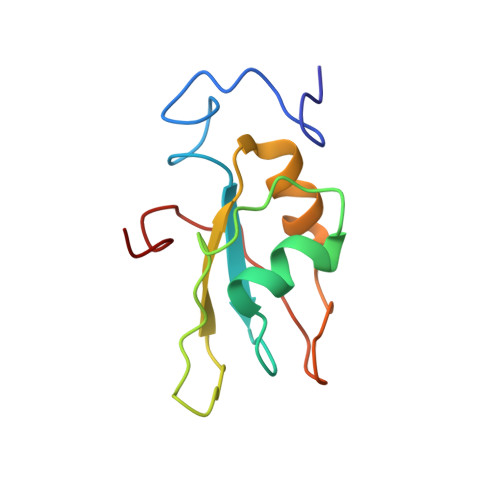Differential Conformational Dynamics Encoded by the Inter-qRRM linker of hnRNP H.
Penumutchu, S., Chiu, L.Y., Meagher, J.L., Hansen, A.L., Stuckey, J.A., Tolbert, B.S.(2018) J Am Chem Soc
- PubMed: 30122033
- DOI: https://doi.org/10.1021/jacs.8b05366
- Primary Citation of Related Structures:
6DG1, 6DHS - PubMed Abstract:
Members of the heterogeneous nuclear ribonucleoprotein (hnRNP) F/H family are multipurpose RNA binding proteins that participate in most stages of RNA metabolism. Despite having similar RNA sequence preferences, hnRNP F/H proteins function in overlapping and, in some cases, distinct cellular processes. The domain organization of hnRNP F/H proteins is modular, consisting of N-terminal tandem quasi-RNA recognition motifs (F/HqRRM1,2) and a third C-terminal qRRM3 embedded between glycine-rich repeats. The tandem qRRMs are connected through a 10-residue linker, with several amino acids strictly conserved between hnRNP H and F. A significant difference occurs at position 105 of the linker, where hnRNP H contains a proline and hnRNP F an alanine. To investigate the influence of P105 on the conformational properties of hnRNP H, we probed the structural dynamics of its HqRRM1,2 domain with X-ray crystallography, NMR spectroscopy, and small-angle X-ray scattering. The collective results best describe that HqRRM1,2 exists in a conformational equilibrium between compact and extended structures. The compact structure displays an electropositive surface formed at the qRRM1-qRRM2 interface. Comparison of NMR relaxation parameters, including Carr-Purcell-Meiboom-Gill (CPMG) relaxation dispersion, between HqRRM1,2 and FqRRM1,2 indicates that FqRRM1,2 primarily adopts a more extended and flexible conformation. Introducing the P105A mutation into HqRRM1,2 alters its conformational dynamics to favor an extended structure. Thus, our work demonstrates that the linker compositions confer different structural properties between hnRNP F/H family members that might contribute to their functional diversity.
Organizational Affiliation:
Department of Chemistry , Case Western Reserve University , Cleveland , Ohio 44106 , United States.














